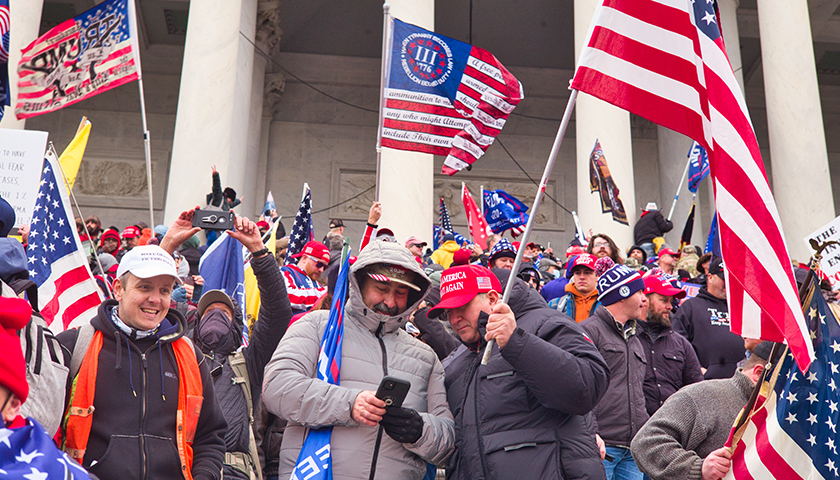by Julie Kelly
Joe Biden calls it the worst attack since the Civil War. Attorney General Merrick Garland compares it to the 1995 Oklahoma City bombing. The FBI is breaking down the doors of Iraq War veterans and small business owners who have no criminal records, and some are hauled off to rot in solitary confinement in a fetid D.C. jail, for their involvement in the alleged travesty.
The event, of course, is the roughly four-hour-long disturbance at the U.S. Capitol on January 6. As mostly nonviolent Americans dared to protest Congress’ certification of a clearly fraudulent presidential election in a place that once was considered “The People’s House,” lawmakers scurried for cover as reporters and photographers captured part of the ruckus on video and still shots to wield as political ammunition against Donald Trump and his supporters.
But have we seen a full and fair depiction of exactly what happened that day? The answer, as evidenced by an ongoing coverup by the U.S. Capitol Police and the Justice Department, clearly is no.
Almost all the January 6 video seen by the public isn’t from official government sources but by social media users and journalists on the scene. For example, the widely viewed footage of protestors occupying the Senate chamber was recorded by a New Yorker journalist.
But thousands of hours of real-time footage is in the hands of the Capitol Police—and that agency, along with government lawyers and federal judges, is using every legal trick possible to keep the trove hidden from the public even as clips are presented in court as evidence against hundreds of January 6 defendants.
According to an affidavit filed in March by Thomas DiBiase, the Capitol Police department’s general counsel, the building is monitored 24/7 by an “extensive system of cameras” positioned both inside and outside the building as well as near other congressional offices on the grounds.
The system captured more than 14,000 hours of footage between noon and 8 p.m. on January 6; the archive was made available to two Democratic-controlled congressional committees, the FBI, and the D.C. Metropolitan Police department. (After a request by Congress, the agency reportedly handed over footage from the entire 24-hour period.)
Capitol Police also produced selective clips for Democratic House impeachment managers to use in the trial against Donald Trump.
But Capitol Police argue that making all the tapes available to defense attorneys —let alone to the American public—could provoke future violence. “The Department has significant concerns with the release of any of its footage to defendants in the Capitol attack cases unless there are safeguards in place to prevent its copying and dissemination,” DiBiase wrote March 17. “Our concern is that providing unfettered access to hours of extremely sensitive information to defendants who already have shown a desire to interfere with the democratic process will . . . [be] passed on to those who might wish to attack the Capitol again.”
The Justice Department, in numerous cases, is seeking protective orders to rigorously limit how surveillance video is handled by defense attorneys. Recordings have been deemed “highly sensitive” government material subject to onerous rules; the accused only have access to the evidence in a supervised setting. Clips cannot be copied, downloaded, shared, or reproduced in any fashion.
“Defense counsel may not provide a copy of Highly Sensitive materials to Defendant or permit Defendant to view such materials unsupervised by defense counsel or an attorney, investigator, paralegal, or support staff person employed by defense counsel,” Judge Amit Mehta wrote in a protective order related to the conspiracy case against members of the Oath Keepers. “The parties agree that defense counsel or an attorney, investigator, paralegal, or support staff person employed by defense counsel, may supervise Defendant by allowing access to Highly Sensitive materials through a cloud-based delivery system that permits Defendant to view the materials but does not permit Defendant the ability to download.”
Sounds legit.
Fighting Back Against the Blackout
But defense attorneys and the media now are fighting the video blackout. During a detention hearing last month for the two men accused of spraying officer Brian Sicknick—both have been behind bars and denied bail since their arrests in March—defense lawyers objected to the government’s use of “cherry-picked” video they couldn’t see in its full context which, if examined, might contain exculpatory evidence.
Under pressure from a group of media outlets, the government finally released what it claims is the incriminating video showing the chemical spray “attack” against Sicknick. (It didn’t.) The choppy video included recordings from several surveillance cameras, a few D.C. police officers, and a bystander.
Journalists continue to be frustrated by the Justice Department’s suppression tactics. In a plea last week to Beryl Howell, chief judge of the D.C. District Court handling all the January 6 cases, 14 news organizations asked for better access to video evidence presented in court. (Virtual court proceedings further help prosecutors keep the clips under wraps.)
“[T]he press and public have not been able to access these videos on the Court’s electronic dockets,” lawyers representing CNN, ABC News, the Wall Street Journal and others wrote in a May 3 letter. “Delayed access to these historic records shuts the public out of an important part of the administration of justice.” The government, the lawyers told Howell, refuses to give a “substantive answer” as to why the video evidence isn’t publicly available and listed several cases where surveillance footage was played in court but not otherwise accessible.
The secret video archive of January 6 isn’t the only recording under scrutiny. It’s also unclear whether Capitol Police kept the footage from January 5. DiBiase said surveillance video is routinely deleted after 30 days; only a “very limited” number of clips from January 5 were given to the U.S. Attorney in D.C., the office handling the massive investigation.
It would be very convenient for the Capitol Police—no objective party in this saga since it launched the lie about Sicknick’s death—to purge footage from January 5 so defense attorneys and the public cannot see what sort of activity took place the day before the “insurrection.”
So what, exactly, is the government trying to hide? How can activity inside and outside a public building be considered “highly sensitive?” In response to a Freedom of Information Act filing by Judicial Watch, Capitol Police told the group the recordings are not “public records.” But of course they are. A security system controlled by a federal agency in a public building paid for by taxpayers to conduct the public business of public officials is most certainly a public record.
Even if legal loopholes allow for such an exemption, the greater public interest should supersede any technicalities. Major parts of the original narrative already have fallen apart, including the story that officer Sicknick was murdered by Trump supporters and the myth it was an “armed insurrection”; the full account of what prompted the killing of Ashli Babbitt by an unidentified Capitol cop is still unknown.
Further, the Biden regime is weaponizing January 6 to hunt down and destroy the lives of people—many of whom committed no violent crimes—anywhere near the building that day. The Justice Department is promising to build sedition cases; Biden’s intelligence chiefs are operating outside their authorization in their effort to portray regular Americans as domestic terrorists.
A president was impeached for his alleged role. Republican lawmakers continue to face threats for objecting to the election results in swing states. And millions of Trump voters, by extension, are considered conspiracy theorists and wannabe “insurrectionists.”
There’s only one reason why the Justice Department wants to keep the footage under seal: it contradicts most if not all of the claims advanced by Democrats and the media over the past four months.
Republicans, to the extent they can or will, and the media should demand the release of all the footage. Ditto for families of the defendants. The American public still doesn’t know exactly what happened on January 6—and it’s clear the government will use any means necessary to keep it that way.
– – –
Julie Kelly is a political commentator and senior contributor to American Greatness. She is the author of Disloyal Opposition: How the NeverTrump Right Tried―And Failed―To Take Down the President. Her past work can be found at The Federalist and National Review. She also has been featured in the Wall Street Journal, The Hill, Chicago Tribune, Forbes, and Genetic Literacy Project. After college graduation, she served as a policy and communications consultant for several Republican candidates and elected officials in suburban Chicago. She also volunteered for her local GOP organization. After staying home for more than 10 years to raise her two daughters, Julie began teaching cooking classes out of her home. She then started writing about food policy, agriculture, and biotechnology, as well as climate change and other scientific issues. She graduated from Eastern Illinois University in 1990 with a degree in communications and minor degrees in political science and journalism. Julie lives in suburban Chicago with her husband, two daughters, and (unfortunately) three dogs.
Photo “Jan. 6 capitol riot” by Brett Davis CC 2.0.







History will one day tell the true story about January 6 and the unarmed truly concerned American people. The justice department is no longer the justice department. We have become a Banana Republic. While decent citizens have been sitting in jail and doors broken down and others terrorized, Antifa and BLM run and destroy freely. The Greatest Generation hang their head in shame at what is happening.